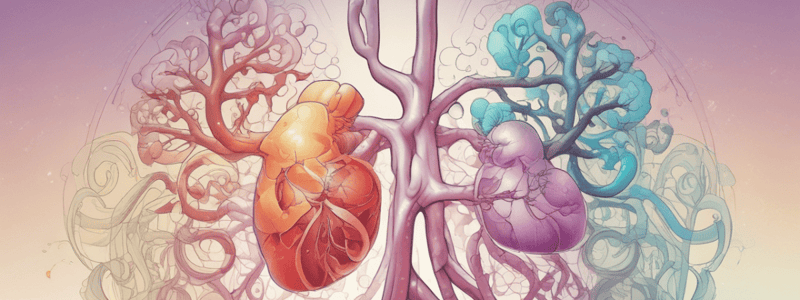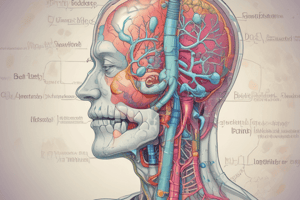Podcast
Questions and Answers
Which type of chronic obstructive pulmonary disease is commonly associated with respiratory acidosis?
Which type of chronic obstructive pulmonary disease is commonly associated with respiratory acidosis?
- COPD exacerbation
- Type A COPD
- End-stage COPD
- Type B COPD (correct)
What is the primary cause of respiratory acidosis in a patient with severe kyphoscoliosis?
What is the primary cause of respiratory acidosis in a patient with severe kyphoscoliosis?
- Hyperventilation
- Impaired neuromuscular function (correct)
- Respiratory muscle fatigue
- Impaired gas exchange
A patient with a severe asthma episode is likely to develop which type of respiratory disorder?
A patient with a severe asthma episode is likely to develop which type of respiratory disorder?
- Respiratory acidosis (correct)
- Metabolic alkalosis
- Respiratory alkalosis
- Metabolic acidosis
Which sign of respiratory acidosis is also associated with hypoxemia?
Which sign of respiratory acidosis is also associated with hypoxemia?
What is the primary cause of respiratory acidosis in a patient with Guillain-Barré syndrome?
What is the primary cause of respiratory acidosis in a patient with Guillain-Barré syndrome?
Which of the following is NOT a common cause of respiratory acidosis?
Which of the following is NOT a common cause of respiratory acidosis?
A patient with acute respiratory distress syndrome is likely to develop which type of respiratory disorder?
A patient with acute respiratory distress syndrome is likely to develop which type of respiratory disorder?
Which sign of respiratory acidosis is also associated with cardiac dysrhythmias?
Which sign of respiratory acidosis is also associated with cardiac dysrhythmias?
What is the primary cause of respiratory acidosis in a patient with chest injury or surgery?
What is the primary cause of respiratory acidosis in a patient with chest injury or surgery?
A patient with end-stage type A COPD is likely to develop which type of respiratory disorder?
A patient with end-stage type A COPD is likely to develop which type of respiratory disorder?
What is the primary factor that determines the partial pressure of oxygen in the blood?
What is the primary factor that determines the partial pressure of oxygen in the blood?
What is the short-term adaptation of the human body to high altitude?
What is the short-term adaptation of the human body to high altitude?
What is the effect of hyperpnea on the body at high altitude?
What is the effect of hyperpnea on the body at high altitude?
What is the formula for calculating oxygen content in the blood?
What is the formula for calculating oxygen content in the blood?
What is the primary factor that determines oxygen saturation in the blood?
What is the primary factor that determines oxygen saturation in the blood?
What happens to the air in the lungs when a diver quickly swims to the surface?
What happens to the air in the lungs when a diver quickly swims to the surface?
What is the result of a rupture of the alveoli?
What is the result of a rupture of the alveoli?
What is Henry's Law related to?
What is Henry's Law related to?
What can happen to the eardrum during descent?
What can happen to the eardrum during descent?
What is a possible consequence of a diver not exhaling properly during ascent?
What is a possible consequence of a diver not exhaling properly during ascent?
What is the primary mechanism by which oxygen toxicity causes cellular damage?
What is the primary mechanism by which oxygen toxicity causes cellular damage?
What is the primary cause of nitrogen narcosis in divers breathing air at high pressure?
What is the primary cause of nitrogen narcosis in divers breathing air at high pressure?
What is the primary treatment for decompression sickness?
What is the primary treatment for decompression sickness?
What is the primary symptom of decompression sickness in 85-90% of people?
What is the primary symptom of decompression sickness in 85-90% of people?
What is the consequence of oxygen partial pressure increasing in the tissues?
What is the consequence of oxygen partial pressure increasing in the tissues?
Flashcards are hidden until you start studying
Study Notes
Acid-Base Balance: Role of the Lungs
- Acid-base balance refers to the regulation of free hydrogen-ion (H+) concentration in the body fluids.
Sources of Acidity
- CO2 + H2O → H2CO3 → H+ + HCO3- (source of acidity)
Regulation of H+ Balance
- The Henderson-Hasselbalch equation is used to calculate how changes in CO2 and HCO3− affect pH.
- pH = [HCO3-] controlled by kidney function / [CO2] controlled by lung function.
Defense Mechanisms against Changes in [H+]
- Three lines of defense operate to maintain [H+] at a nearly constant level (pH 7.4):
- Chemical buffer systems
- Respiratory mechanism of pH control
- Renal mechanism of pH control
Respiratory Mechanism of pH Control
- Ventilation can compensate for pH disturbances.
- Increased H+ concentration stimulates respiration, which increases alveolar ventilation and decreases H+ concentration.
Relationship between Respiration and pH
- High concentrations of hydrogen trigger hyperventilation.
- Respiratory system is a negative feedback mechanism.
- In hypoventilation, we have increased CO2 levels.
Respiratory Acid-Base Regulation
- Acts at a moderate speed.
- Activated when chemical buffer systems alone are unable to minimize pH deviations.
- Requires a few minutes to be initiated.
- Respiratory system serves as the second line of defense.
Respiratory Compensation
- Peripheric chemoreceptors and central chemoreceptors are involved in respiratory compensation.
Respiratory Acidosis
- Causes:
- Impaired gas exchange
- Type B chronic obstructive pulmonary disease (COPD)
- Bacterial pneumonia
- Severe asthma episode
- Pulmonary edema
- Acute (adult) respiratory distress syndrome
- Impaired neuromuscular function
- Chest injury or surgery (pain limits ventilation)
- Hypokalemic respiratory muscle weakness
- Severe kyphoscoliosis
- Respiratory muscle fatigue
- Impaired respiratory control (brainstem)
- Respiratory depressant drugs (opioids, barbiturates)
- Signs and symptoms:
- Headache
- Tachycardia
- Cardiac dysrhythmias
- Neurologic abnormalities
- Blurred vision
- Tremors
- Vertigo
- Disorientation
- Lethargy
- Somnolence
Respiratory Alkalosis
- Causes:
- Hypoxemia
- Signs and symptoms:
- Increased neuromuscular excitability
Oxygen Pressure (pO2)
- Oxygen molecules dissolved in plasma impinge on the measuring oxygen electrode, reflecting the partial pressure of oxygen
- The number of O2 molecules dissolved in plasma determines how many molecules will bind to hemoglobin
- PaO2 only measures free oxygen molecules, not oxygen bound to hemoglobin
Oxygen Saturation (SaO2)
- Percentage of available heme binding sites saturated with oxygen
- Measured as the hemoglobin oxygen saturation
Oxygen Content (CaO2)
- Calculated by multiplying hemoglobin concentration, oxygen-carrying capacity of hemoglobin, and oxygen saturation
- Formula: CaO2 = Hb (gm/dl) x 1.34 ml O2/gm Hb x SaO2 + PaO2 x (.003 ml O2/mm Hg/dl)
Acclimatization to High Altitude
- The body adapts to high altitude through immediate and long-term acclimatization
- Short-term adaptation: increased breathing depth and rate (hyperpnea) due to carotid body sensing lack of oxygen
- Hyperpnea leads to respiratory alkalosis, which inhibits further respiratory rate enhancement
Oxygen Toxicity
- Breathing oxygen at high pressure (4 atm) causes seizures, coma, muscle twitchings, dizziness, and other symptoms
- Oxygen toxicity leads to formation of oxygen free radicals, damaging cell membranes and enzymes
Nitrogen Narcosis
- High pressure causes nitrogen to dissolve in fat tissues, including neuronal membranes, reducing neuronal excitability
Decompression Sickness
- When a diver surfaces too quickly, nitrogen bubbles form in body fluids, blocking blood vessels and causing tissue ischemia and death
- Symptoms include pain in joints and muscles, nervous system symptoms, and shortness of breath
Treatment of Decompression Sickness
- Gradual decompression in a pressurized tank to normal atmospheric pressure
Diving Problems
- Descending: compression of gases causes eardrum rupture, sinus damage, lung squeeze, and eye problems
- Ascending: rapid pressure change causes re-expansion of gases, leading to pulmonary barotrauma and air embolism if not exhaled properly
Henry's Law
- At constant temperature, the amount of gas dissolved in a liquid is directly proportional to the partial pressure of that gas
Studying That Suits You
Use AI to generate personalized quizzes and flashcards to suit your learning preferences.




